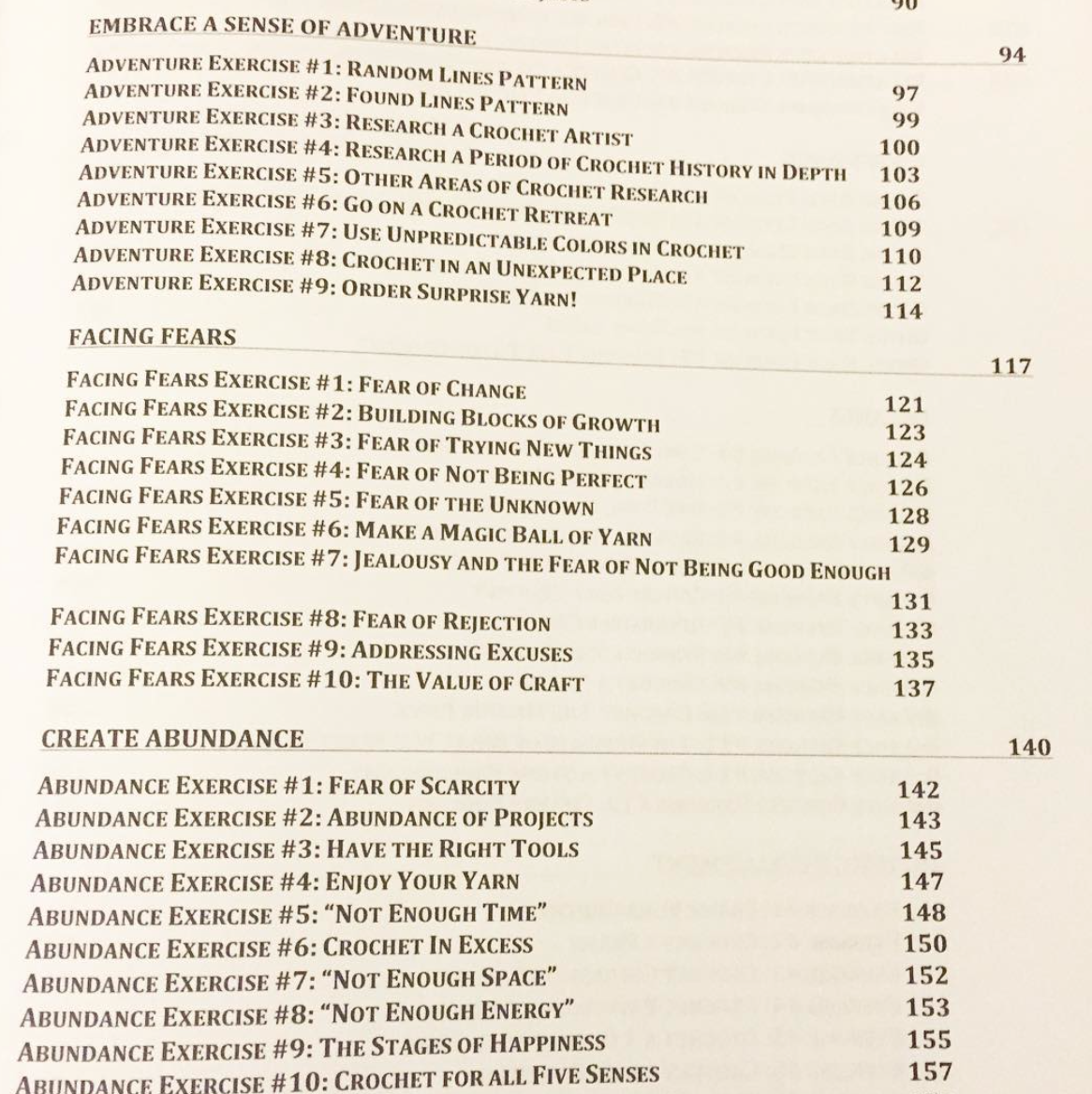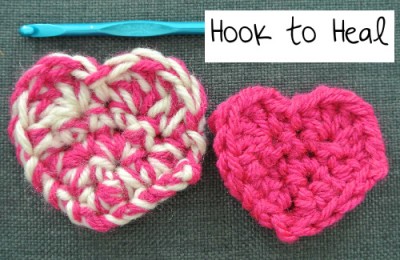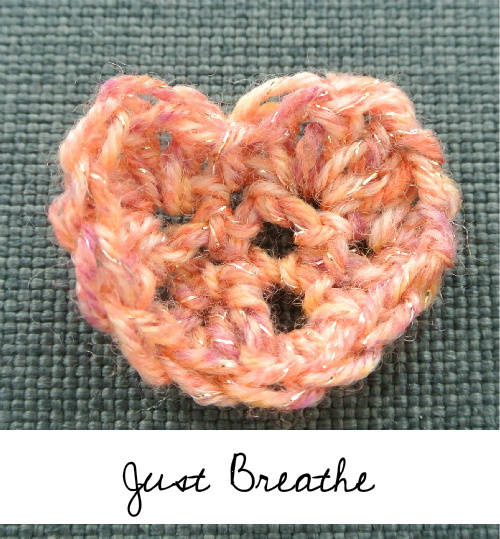Crocheting isn’t just about making garments and gifts. Crochet can help us heal in a variety of ways and help us find balance, improve our relationships, build our self-esteem, give back to the world and honor the artist within.

That’s what Hook to Heal, my brand new crochet book, is all about. The book is filled with crochet exercises designed to help you use crafting to expand both your inner and outer worlds. Keep reading to learn a little bit more about the book and see what the exercises are like. Then, enter for a chance to win your own copy!
About Hook To Heal

Hook to Heal table of contents
Hook to Heal features 100 creativity exercises that use crochet as a medium for personal growth. Unlike typical crochet books, this one doesn’t include crochet patterns or instructional photos, and it will not teach you how to crochet. Instead, I cover many different topics, such as:
- Mindfulness
- Letting go
- Self-care
- Self-esteem building
- Embracing adventure
- Facing fears
- Creating abundance
- Growing relationships
- Giving back; connecting to the world
- Working towards balance
- Artistic development
Each chapter includes my thoughts about the topic, derived from my own experience using crafting to heal. My graduate studies in Integral Counseling Psychology and research into the health benefits of crochet play a part in the book, too. Each chapter ends with related “yarn for thought” questions that you can use for further self-inquiry into the topic. I’ve successfully used every single one of these exercises in my own personal development.
Hook to Heal is available for sale through Amazon in both Kindle and paperback versions.

Sample exercise: The “Wrong” Materials
This is one of the exercises in the “Letting Go” chapter of Hook to Heal — a chapter that’s all about letting go of the pressure that you place on yourself related to crafting (and life!). It’s about using yarn to let go of fears, self-judgment and unrealistic expectations and get back to the basics of enjoying what crafting is all about.

The exercise
Crochet a project using an entirely different yarn and hook from what the pattern requires.
The purpose
Making an item that is impractically tiny or large will allow you to focus on the process of crafting rather than the product. You’re letting go of the end product and investigating what the process of the work can offer to you.
In depth
Explore the emotions that come up as you create something you might see as useless or pointless. This exercise can teach you a lot about why you crochet and what you get out of it, information you can use to improve your future crafting experiences.
Exercise steps
1. Choose a pattern. You can choose any pattern at all, of course, but if it’s your first time doing this exercise then you might want to pick a fairly straightforward pattern that’s easy to follow. I like to pick patterns that will be humorous when done this “wrong way” — hats that look silly when they are too large or too small, for example.
2. Choose your crochet hook. You want to select a hook that is very different in size from the hook suggested in the pattern. This is easy if the hook is small or large; just choose the opposite. If you select a pattern with a mid-sized hook (G or H, for example) then you’ll have the choice to go smaller or larger (D or N, let’s say).
3. Choose your yarn. There are two important considerations here. First, you want to choose something that differs from the suggestion in the pattern. You might change the fiber, the weight or both. So for example, if you’re working a basic crochet scarf pattern with a worsted weight acrylic yarn, you might instead choose to use a fine weight silk yarn or a bulky weight T-shirt yarn. Before you finalize your decision, though, make sure that you can work this yarn with the hook that you’ve chosen. Sometimes it’s fun to work a weight that differs from the norm for a hook; for example, I’ve done a lot of work using an N hook with a lace weight yarn for an open design. Sometimes, though, it’s just impossible to pair a hook with a certain yarn; if you’re using a tiny thread crochet hook then it may be impossible to use thick T-shirt yarn with it.
4. Work through the pattern. Follow the instructions exactly like they are but with your new materials. Practice mindfulness with this exercise, paying attention to all of the senses and all of the feelings that arise as you work this seemingly pointless project.
5. Enjoy the finished item! Laugh at it. Share it. Celebrate it. You made something totally pointless and that means that you let go of function, even if just for a moment.
6. Decide what to do with your finished object. If you really want to immerse yourself in the “letting go” then the end product doesn’t matter at all. You can just give it away or frog it at this point. But you might also find that the finished item is lovely in its own way and actually has a use that you didn’t imagine when you began. A smaller-than-normal scarf might be a good gift for a little girl in your life; a too-big bag can become a laundry hamper. Although you shouldn’t think about these purposes as you work the project, it’s interesting to see how something can become useful or artistic once it’s finished. There’s magic at work in letting go and also magic in finding inspiration in something finished.

Tips
- Ignore rules about gauge; they don’t apply here.
- Consider choosing the hook and yarn you most like to work with. If you don’t like fiddly work, for example, then you might not want to choose a very small steel crochet hook and thread to work this exercise — at least not the first time through. You’re supposed to enjoy this, after all!
- It’s likely that a thought will come up along the lines of, “what’s the point of this?!” Think of it as a practice like in meditation; notice the thought but don’t cave in to it. There’s value in working through that as you learn to let go of the end product.
- Once you’ve done the exercise once through, try it again using different materials. (For example, if you worked it using a large hook and T-shirt yarn, do it again in thread crochet with a small hook.)
Taking it further
Run through this exercise six times using different patterns and making different changes with each pass through. At the end, you’ll have half a dozen items to put together into a mixed media art display. Get creative! You might put several tiny crochet scarves onto the outside of an oversized crochet bag (appliqué-style). Or perhaps a too-large scarf can serve as a wall hanging and the other items can be attached to that. Play around, explore, get dirty, make something new.
This is one example of the exercises in Hook to Heal. You’ll find dozens more in the book!
GIVEAWAY!

One lucky Bluprint reader will win their own copy of Hook to Heal! The winner can choose between the paperback or Kindle versions of the book. Open to participants in all areas.
Entering is easy: Just click the button below and log into your Bluprint account (or create one — it’s free!) to enter the giveaway. That’s all there is to it! Can’t wait to find out if you won? You can buy Hook to Heal on Amazon.

Share tips, start a discussion or ask one of our experts or other students a question.
No Responses to “You Could WIN A Book Full of Crochet Creativity Exercises!”